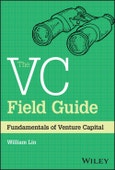Venture capital is the economic engine that drives entrepreneurship and innovation through capital investments, board membership, advice, introductions to relevant employees, and customers. Despite the outsized importance of venture capital, the inner workings remain hidden. Venture is still a mentor-led industry and it is an industry where you have to do a lot of self-education - you have to learn by doing, and you have to get up to speed quickly.
Until now.
Author William Lin spent over a decade in venture capital, starting in an entry-level position, helping to start a leading VC firm from scratch, and eventually becoming Managing Partner. In The VC Field Guide: Fundamentals of Venture Capital, Lin shares his unique framework, the Venture Capital Investment Framework, to help any venture capitalist, entrepreneur, or investor make better investment decisions, quicker. He delivers an incisive and practical handbook for the world of venture capital. You’ll learn about the industry, how to break into it, and discover the art of investing in startups, and more, including: - How VC deals are analyzed, vetted, and made - Which questions experienced and successful venture capital investors ask startup founders when making investment decisions, and why those questions matter - The venture capital mindset that dominates the thinking of the most prominent venture capital investors - The best ways to begin a career in venture capital and tips on advancing your career - Key differences between multi-stage and boutique firms and what it means for entrepreneurs - The different factors VCs use to evaluate early-stage versus late-stage companies
If you want to be close to company creation and innovation as a venture capitalist, investor, or entrepreneur, this book is for you. If you want to be involved in situations that impact economic growth, innovation, and the founders, employees, vendors, and communities that support the broader entrepreneurial ecosystem, this book is for you. The VC Field Guide is not only a primer on the inner workings of the venture capital industry, but a timely framework for how investment decisions are made. Anyone who wants to better understand how venture capital investments are made, and why will find this book helpful.
Table of Contents
Foreword xi
Preface xiii
Acknowledgments xv
Part I Introduction 1
Introduction 3
My Background 3
Who Is This Book For? 9
The Framework’s Origin 10
Endnote 14
Part II The Venture Capital Investment Framework 15
Chapter 1 The Venture Capital Investment Framework 17
Startup Investing 17
Chapter 2 Who = Team 23
Different Paths to Success 26
Curiosity Is a Must- Have for Founding Teams 27
Individual or Company Growth? 30
The CEO and Team Challenges 31
Curiosity and ? 33
Failure Is a Valued Asset 37
In- Person Data 38
Team Dynamics that Work 40
Chapter 3 What = Problem 47
Deep Questions, First Principles 49
Common Sense and Bias 52
You Don’t Have to Solve Your Own Problem 53
Finding a Problem 55
Chapter 4 When = Timing 59
Timing = Environment 61
Specialization Leads to Success, Leading to Optionality 62
Generational Timing 64
Timing and Disruption 66
The Rise and Fall of Companies 68
Chapter 5 Where = Market 73
How VCs Look at TAM 74
Strategy for VCs Based on the Size of the Firm 79
Calculating TAM and What Does It Imply? 81
Chapter 6 Why = Solution 83
Solving One Problem Really Well 85
Building the Right Solution 87
Building a Sustainable Business 90
Chapter 7 How = Scale 91
The Sales Organization 93
Sales Organization and Customer Alignment 96
The Technology Organization 98
Chapter 8 How to Use the VCIF 101
The VCIF in Action: An Investment We Made 102
An Investment We Didn’t Make 107
Stages 112
Part III Notes to Stakeholders 115
Chapter 9 The Venture Capital Role 117
The Basics of a Venture Capital Firm 118
Winners Lose a Lot 123
Metrics 126
My First Trial by Fire 128
Chapter 10 Notes for Students 135
Three Entry- Level Career Paths in Venture 135
Chapter 11 Notes for Current VCs 141
VC Career Paths 141
VC Career Myths 147
Chapter 12 Notes for Entrepreneurs: Some Thoughts 151
Chapter 13 Notes for Startup Customers 155
Chapter 14 Notes for LPs: Characteristics of Some of the Best VCs 159
Sector Knowledge 161
Chapter 15 Long- Term Planning: Venture Capital Cycles, Optionality, Starting a VC Firm 165
Venture Capital Cycles 167
Optionality 168
Could You Start Your Own VC Firm? 172
Conclusion 175
Afterword 179
Glossary 181
Index 185








